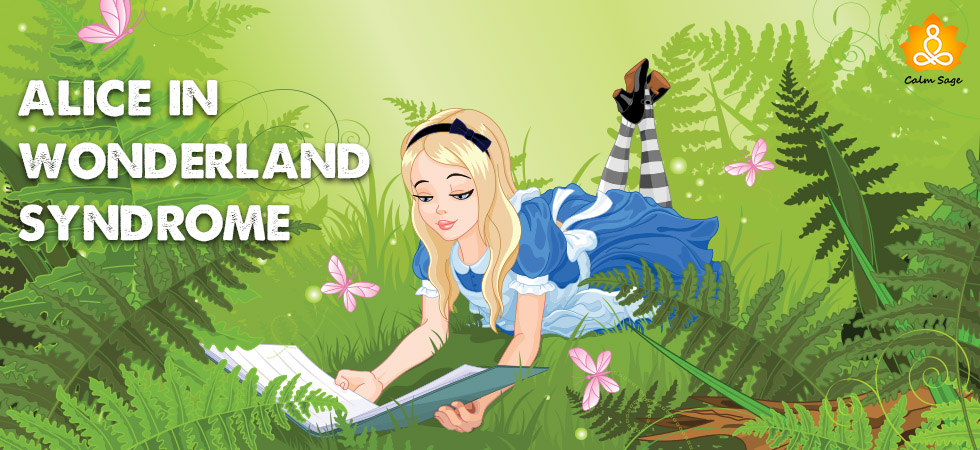Alice in Wonderland Syndrome: Symptoms, Causes, and Treatment

Alice in Wonderland is widely known as a popular children’s novel by author Lewis Carroll and was adapted into a movie by Disney that won the hearts of many. But there exists a mental health condition as well with the same name as this classic novel.
Well, if you look closely at adaptations of Lewis Carroll’s Alice in Wonderland majority of the characters present symptoms of various mental health conditions. You may take for example the caterpillar showing signs of addiction and delusion of grandiosity, similarly, the rabbit was always anxious correlating with the signs of Generalised Anxiety (GAD).
This infusion of mental health in Alice in Wonderland is the reason why we have mental health conditions named after the main characters here- Alice in Wonderland Syndrome. Read on to find more about it.
What is Alice in Wonderland Syndrome
Alice in Wonderland SYndrome was first described by John Todd in 1955. According to AIWS is marked by perceptual distortions which resemble time distortions, derealization, depersonalization, and bodily changes. It is quite similar to what Alice experienced after jumping into that hole and finding herself in the woods of Wonderland. Wherein the objects around will either suddenly appear bigger (macropsia) or tinier (micropsia).
These distortions are not hallucinations or illusions. They are experienced by a person in light of appropriate stimuli which is altered due to neurological reasons.
You can also understand AIWS with the help of this analogy: Binocular Vision. Just like a binocular either makes everything around us look too big or too small, AIWS causes the same distortions. It is a rare neurological condition usually experienced by children and at times affecting children too. Usually, an individual outgrows this with age and time, sometimes treatment may be required for the same.
Why Is It Called Alice in Wonderland Syndrome
The protagonist, Alice in Lewis Carroll’s book Alice in Wonderland experienced similar situations that occur in this mental health condition. That is why the English psychiatrist John Todd named it Alice in Wonderland Syndrome. AIWS is also referred to as Todd’s Syndrome.
Trivia: Lewis Carroll the author of the book Alice in Wonderland too experienced AIWS while writing his book. His acute migraine resulted in visual hallucinations which he penned down in the form of Alice in Wonderland. This is yet another reason why this syndrome is called Alice in Wonderland Syndrome.
Signs and Symptoms of Alice in Wonderland Syndrome
Interestingly the signs of the Alice in Wonderland Syndrome episode are likely to differ from person to person. Some of the major symptoms that an individual is likely to show in an AWS episode are:
1. Migraine: Alice in Wonderland surely has some association with Migraine (even the trivia supports it). But whether it is a cause or effect relationship is yet to be established. While some researchers believe it to be an early sensory indication of migraine others support that it is a rare subtype of migraine in itself. Either way migraine and AWS are interlinked.
2. Size Distortions: An individual with Alice in Wonderland Syndrome is likely to experience either of the two forms of size distortions:
- Micropsia: It is a sensation that everything around you grows smaller and tinier.
- Macropsia: Opposite of micropsia is macropsia. Here the sensations make you feel your body and surroundings growing larger than usual.
3. Time Distortion: The distorted vision of time may lead an individual to lose their sense of time. They might feel that either the time is moving too fast or too slow for them.
4. Perceptual Distortions: Again there can be two different conditions of perceptual distortion that an individual with Alice in Wonderland Syndrome may experience. This includes:
- Pelopsia: Objects will appear larger and closer than they really are.
- Teleopsia: Sensation of objects getting smaller and farther away than they are.
5. Sound Distortions: No matter how low or quiet the sound is, an individual experiencing AIWS is likely to perceive it loud and intrusive.
6. Others: Along with the signs of AIWS discussed above some other signs may also show up.
- Feeling of derealisation, depersonalization, and somatopsychic duality.
- Dysmorphopsia: Line and contours appearing wavy.
- Achromatopsia: Inability to perceive color.
- Feverish symptoms.
- Epileptic seizures affect only part of the brain.
- Loss of limb control or loss of coordination. Muscles may feel like they are acting involuntarily.
Note: An episode of AWS highlights one of these symptoms for 5-15 minutes.
Causes of Alice in Wonderland Syndrome
It is still unknown what causes Alice in Wonderland Syndrome. However, different researches have converged on a few factors that were found common among different cases of AIWS. These factors that are likely to be the cause of Alice in Wonderland Syndrome are:
1. Brain Activity:
Unusual electrical activity in the brain causes abnormal blood flow which alters the way we perceive ourselves and our surroundings. This unusual brain activity can be a reason why an individual experiences Alice in Wonderland syndrome. Apart from it, other brain conditions like epilepsy, brain injury or trauma, brain lesion, and brain tumor are also linked with AIWS.
2. Infections: According to a study 33 percent of people with AIWS also experienced infections, indicating a link between AIWS and infections. Another study also supported this finding. Some of the common infections that can trigger the signs of AIWS in an individual are:
-
- Epstein-Barr Virus.
- Influenza A Virus.
- Mycoplasma
- Varicella-zoster Virus
3. Migraine: As discussed above migraine is both a cause and a sign of Alice in Wonderland Syndrome. In fact, migraine is identified as the most common cause underlying AIWS.
4. Others: Apart from the three major causes of AIWS discussed above there are some other factors that can contribute to this condition. This includes:
-
- Stress.
- Stroke
- Cough medicine or other medications.
- Use of hallucinogenic drugs.
Note: In adults, migraine is the leading cause of Alice in Wonderland Syndrome. However, in the case of children, it is an infection that puts them to risk.
Treatment of Alice in Wonderland Syndrome
To date, there is no treatment for Alice in Wonderland Syndrome. Although certain treatment and management approaches have been suggested by the field experts.
1. Taking care of migraine
From the above discussion, one thing is clear migraine and Alice in Wonderland Syndrome are closely related. No matter whether it is a sign or a cause of AIWS taking care of migraine is the step towards bringing relief to its symptoms. Having a diet that prevents migraines and taking preventive medicines is recommended.

2. Practicing self-care
Excessive stress is one of the leading causes behind AIWS. To combat stress and control the symptoms of AIWS managing stress and practicing self-care is important. The three core aspects of self-care that you should be focusing on are:
- Mediation
- Relaxation techniques.
- Building a stronger immune system to ward off infections (another cause underlying AIWS).
3. Learning patience
In the majority of cases, the condition of Alice in Wonderland Syndrome gets resolved on its own. But for this time to pass smoothly and without welcoming more complications it is crucial for you to be patient with yourself and those around.
Understanding Alice in Wonderland Syndrome Through Videos
Vlog 200: Living with Alice in Wonderland syndrome
Alice in Wonderland Syndrome
Final Thoughts…
Alice in Wonderland Syndrome is a unique and rare mental health condition. Although it tends to resolve automatically in more than 2/3rd of cases, the uncomfortableness that it brings in can be managed for overall wellness.
Did you find this read interesting and informational? Do share your thoughts in the comments section.
Thank you for reading!





















